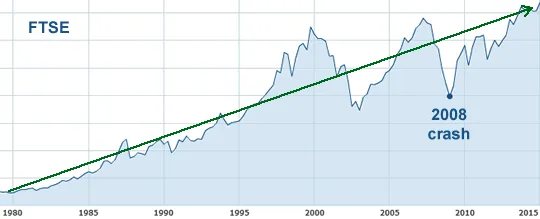Introduction : How to Trade Stocks UK
- Definition of stock trading
- Importance of stock trading in the UK
- Overview of the different types of stocks available in the UK market
Welcome to our guide on how to trade stocks in the UK! Stock trading refers to the buying and selling of stocks, or shares of ownership in a publicly traded company. In the UK, the stock market plays a vital role in the economy, providing a platform for companies to raise capital and for investors to earn potential returns on their investments. There are a variety of different types of stocks available in the UK market, including large-cap, mid-cap, and small-cap stocks, as well as stocks in different sectors and industries.
In this guide, we’ll walk you through the steps you need to take to get started with stock trading in the UK, from setting up a trading account to developing a trading strategy and managing risk. Whether you’re a beginner looking to dip your toes into the stock market or an experienced investor looking to expand your portfolio, this guide has something for you.
Setting Up a Stock Trading Account
- Choosing a brokerage firm
- Opening a stock trading account
- Funding your account
One of the first steps to take when you’re ready to start trading stocks in the UK is to set up a stock trading account. The easiest way to do this is through a brokerage firm, which is a company that facilitates the buying and selling of stocks on behalf of clients. There are a number of brokerage firms to choose from in the UK, and it’s important to do your research and find one that meets your needs and fits your budget. Some factors to consider when choosing a brokerage firm include the fees they charge for trades, the types of accounts they offer, and the user-friendliness of their trading platform.
Once you’ve selected a brokerage firm, you’ll need to open a stock trading account and fund it with the money you’ll be using to make trades. This typically involves filling out an application and providing some personal and financial information. Some brokerage firms may also require you to complete a risk assessment to help determine your suitability for certain types of investments. It’s a good idea to shop around and compare different brokerage firms to find the one that best meets your needs. Keep in mind that some firms may have minimum account balance requirements or charge higher fees for certain types of trades, so be sure to read the fine print and understand all the terms and conditions before signing up.

Understanding the UK Stock Market
- Understanding the different exchanges in the UK (e.g. London Stock Exchange, AIM)
- Understanding the different sectors and industries in the UK market
- Keeping up with market news and analysis
To be successful at stock trading in the UK, it’s important to have a good understanding of the stock market itself. This includes understanding the different exchanges where stocks are traded, such as the London Stock Exchange and the Alternative Investment Market (AIM). The London Stock Exchange is the largest and most well-known exchange in the UK, and it lists a wide variety of stocks from different sectors and industries. The AIM, on the other hand, is a market for smaller and growing companies, and it offers a more flexible listing process for these firms.
It’s also important to have a basic understanding of the different sectors and industries that make up the UK market, as this can help you make informed decisions about which stocks to buy and sell. For example, the financial sector includes companies in the banking, insurance, and investment industries, while the technology sector includes companies involved in the production and distribution of software, hardware, and other technology products. Understanding the different sectors and industries can help you identify trends and opportunities, and build a diversified portfolio that is well-suited to your investment goals and risk tolerance. Keeping up with market news and analysis is also crucial for staying up-to-date on the latest developments and trends in the stock market. This can help you make informed decisions about when to buy and sell stocks and manage your portfolio effectively.
Developing a Trading Strategy
- Setting investment goals and risk tolerance
- Understanding different trading strategies (e.g. fundamental analysis, technical analysis)
- Creating a trading plan
Before you start trading stocks in the UK, it’s important to have a clear idea of your investment goals and risk tolerance. This will help you determine which stocks and trading strategies are right for you. For example, if you’re looking for steady, long-term growth, you might want to focus on stocks that pay dividends and have a history of steady earnings growth. If you’re willing to take on more risk in exchange for the potential for higher returns, you might be more interested in speculative stocks or growth-oriented strategies.
Creating a trading plan is an essential part of successful stock trading. A trading plan should include your investment goals, risk tolerance, and a set of rules for when to buy, sell, and hold onto stocks. It should also outline your preferred trading strategies and the criteria you use to select stocks. By having a clear plan in place, you’ll be better prepared to navigate the stock market and make informed decisions. Remember, it’s okay to make adjustments to your trading plan as you gain more experience and your goals and circumstances change. It’s important to be flexible and adaptable as a trader, while still staying true to your overall investment objectives.

Placing Trades: How to Trade Stocks UK
- Understanding the different types of orders (e.g. market orders, limit orders)
- Placing trades through your brokerage platform
- Monitoring your trades and making adjustments as needed
Once you have a trading account set up and a clear plan in place, you’re ready to start placing trades. There are a few different types of orders you can use when buying and selling stocks in the UK, including market orders and limit orders. A market order is an instruction to buy or sell a stock at the best available price, while a limit order is an instruction to buy or sell a stock at a specific price or better. Understanding the different types of orders and when to use them can help you execute trades efficiently and effectively.
Placing trades through your brokerage platform is typically a straightforward process. Most platforms have an easy-to-use interface that allows you to enter orders and track your trades in real-time. Once you’ve placed a trade, it’s important to monitor your positions and make adjustments as needed. This can include setting stop-loss orders to minimize potential losses or taking profits when a stock reaches a certain price target. By staying on top of your trades and making timely adjustments, you can maximize your chances of success in the stock market.
Managing Risk
- Understanding the risks of stock trading
- Using stop-loss orders to mitigate risk
- Diversifying your portfolio
Risk is an inherent part of stock trading, and it’s important to understand and manage it effectively in order to be successful. One key strategy for managing risk is to use stop-loss orders, which are orders that automatically sell a stock when it reaches a certain price. This can help you minimize potential losses if the stock begins to decline. It’s a good idea to set stop-loss orders at a level that is reasonable given your risk tolerance and investment goals. For example, if you’re willing to take on more risk in exchange for the potential for higher returns, you might set your stop-loss orders at a wider range. On the other hand, if you’re more risk-averse, you might set your stop-loss orders at a tighter range.
Another important strategy for managing risk is to diversify your portfolio, which means spreading your investments across a range of different stocks and sectors. This can help mitigate risk and improve your chances of success. For example, if you have a portfolio that is heavily concentrated in the financial sector and the financial sector experiences a downturn, it could have a negative impact on your portfolio. By diversifying your portfolio, you can reduce the risk of loss and improve your chances of success over the long-term. It’s also a good idea to keep an eye on your portfolio and make sure it’s well-balanced and aligned with your investment goals and risk tolerance. By understanding and managing risk effectively, you can increase your chances of success in the stock market.

Conclusion : How to Trade Stocks UK
- Recap of the steps to take to get started with stock trading in the UK
- Importance of continuing to educate yourself and develop your skills as a trader
In conclusion, “how to trade stocks in the UK” is an important topic for anyone looking to invest in the UK stock market. By following the steps outlined in this guide, you’ll be well on your way to getting started with stock trading in the UK. This includes setting up a stock trading account, understanding the different exchanges and sectors in the UK market, developing a trading strategy, and placing trades through your brokerage platform. It’s also crucial to manage risk effectively by using stop-loss orders and diversifying your portfolio.
As you gain more experience with “how to trade stocks in the UK,” it’s important to continue educating yourself and developing your skills as a trader. The stock market is constantly changing, and it’s essential to stay up-to-date on the latest trends and techniques. By continuing to learn and grow as a trader, you’ll be well-equipped to navigate the ups and downs of the stock market and achieve your investment goals. Whether you’re a beginner looking to get started with stock trading in the UK or an experienced investor looking to expand your portfolio, we hope this guide has provided you with the information you need to succeed.
Keep Following InveShares for more such awesome content right here!
